Interpreting Khachaturian's music
He “plowed up” new, hitherto untouched layers of the musical folklore of the Caucasus and, using the traditions of folk and professional music, created works of inimitable originality, thoroughly modern and permeated with the traits of genuine innovation. Today it is difficult to imagine Soviet and world musical culture without Khachaturyan (Shostakovich, cited in Yuzefovich, 1985, Introduction).
PIANO CONCERTO
Apparently my attraction for the “concert style,” for colorful virtuosity, is characteristic of my creative individuality. I like the very idea of writing a composition with a predominating, joyously vibrant beginning of free competition between virtuoso soloist and symphony orchestra (Khachaturian, cited in Yuzefovich, 1985, p. 95).
Performing Khachaturian’s piano concerto in February 2018 was a milestone for me. By then much had changed since the start of the project. The piano concerto has been a core in the project, it was the initial element from which it all started: I listened to different recordings of the piano concerto and started to reflect on what exactly I would have done differently if I was to play it myself. What I was missing? This was a peculiar inner sense that would not leave me until I would go deeper and carry out profound explorations both within and outside of myself - to have the music of the concerto in my fingers, and to find my way of interpreting and sharing it with people in a live performance. This may sound like an ambitious idea – the striving to find one’s own way to approach such a famous composition as the piano concerto is and, since Khachaturian wrote it in 1936, a number of pianists have indeed already interpreted it: Lev Oborin, Arthur Rubinstein, William Kapell, Moura Lympany, Alicia de Larrocha, Boris Berezovsky, and Svetlana Navasardyan, to name but a few. In the Bibliography, under Links, I present several recordings of Khachaturian’s piano concerto and chamber compositions, as well as Komitas’ compositions performed by a number of Armenians and musicians of other nationalities who are well known in the performance field of Armenian music. The recording list presents interesting and different approaches with regards to the interpretation of Khachaturian’s and Komitas’ music.
To me, Khachaturian’s music evokes an enormous large palette of expressiveness on the piano, with fundamental contrasts in atmosphere and character, from energetic and boldly decisive to more introverted and melancholic in character; from heroic, powerful and virtuosic expression, to more meditative, folk-inspired simplicity and linear melodic monologues; from sharp, peculiar drynesses of dissonant chords and seconds to more subtle and flexible pianistic textures flowing like cascades of sound; from a dry, direct touch/attack on keyboard to a more supple, soft touch, like slowly diving into the keys, from the percussive-like dhol to softness like the plucking on the tar, or with the heart-warming, vibrating, velvet timbre, like the sound of the duduk; from free improvisational flow to precise and vertical drawing.
Khachaturian’s unique artistic creativity sculpted these various aspects within one organic union of the compositional form and concept, and my artistic curiosity strived to reveal what I sensed and imagined in Khachaturian’s music, to explore and underline my musical ideas in light of Armenian folk music. Bellow, I describe the details of my choices in articulation, pedalling and musical timing in the piano concerto.
1st movement - Allegro Maestoso
The principal theme I find to be a heroic declamation - full of energy and boiling power. The rhythmical structure makes it sound very bold and decisive, determined from the very beginning of the exposition. After the short intro from the orchestra, full of massive chords and powerful motion, the principal theme on the piano makes the competition between the orchestra and the soloist thrilling and exciting. The pedal was an essential element to decide upon in relation to this theme, able to change the whole expression of it. I have chosen no pedal on first two notes and, after this - pedal after the third beat, and later, when the theme continues, I make sure that I do not have too much pedal on the third beat. This makes it sound clear, without blurring the syncopated, accented notes of the theme and making it sound like a harmonic mass. I attached particular importance to the fingerings of the small seconds - the so-called Khachaturianesque seconds (intervals). I use my thumb on the edge of the keyboard to play the two notes of minor seconds with the octave. This is very special, because it comes from the Armenian folk-instrument tuning that Khachaturian listened to from childhood. He considered those dissonant intervals to be a perfect consonance. Playing these seconds with only the thumb is unusual, and is uncomfortable because, as classically trained pianists, we do not often have such chords in compositions requiring the use of the thumb on two notes within the chord - one on a black key and one on a white key. After some time though, for me it felt very comfortable and natural. I had experienced such fingerings on chords in the music of Ravel, the Alborada del gracioso, where composer’s significant inspiration was from Spanish folk music, and where it was possible for me to hear the imitation of the sound of castanets and guitar on the piano. To me, these intervals of dissonant seconds evoke the feeling of folk instruments’ raw, unrefined sonority, and the peculiarities of their tuning.
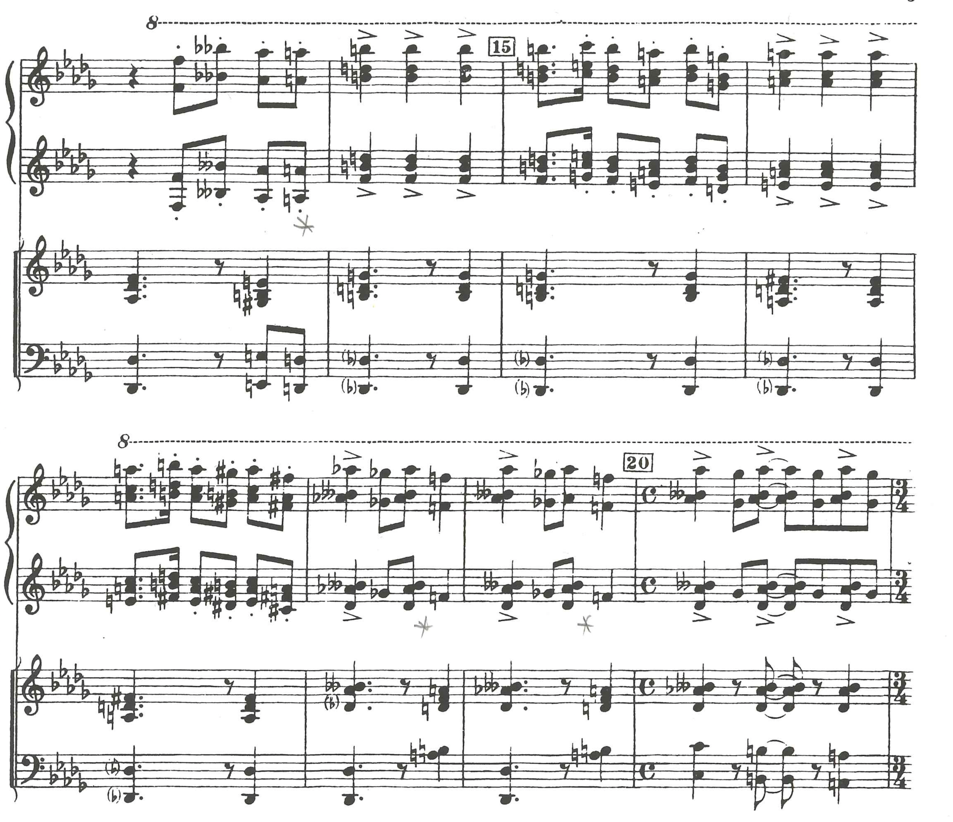
Score example 16, Piano Concerto, 1st mov. bars 13-20
The lyrical secondary theme is, for the first time, presented by orchestra on a solo oboe, and it is possible to imagine here the duduk’s timbre playing the melody like a folk-style lyrical song, accompanied by the harmonic lines of violas (imitating qyamancha) and supported by cellos and clarinets as basso continuo, where we can draw a parallel to the tradition of dam. The expression of music is idyllic and otherworldly, “here nothing disturbs the lucid clarity of the profound feeling, which the lyrical folk character has evoked in the consciousness of the artist” (Khubov, 1977, p. 173, my translation from Armenian).
Poco meno, the solo piano part of the lyrical secondary theme, sounds in the style of a folk song, enriched by delicate ornaments and introducing a great characteristic contrast to the first theme’s energetic mood. This theme is composed freely, like a cadenza (before the main cadenza) in the first movement: a very unusual way to implement the classical sonata form into the piano concerto genre by extending the secondary theme in the piano part as a solo cadenza. This part I aimed to play freely and with a great sense of folk spirit, phrasing the rhythmical lines more freely, exploring different ways of using ornaments and articulations. In such parts, composed very freely, I aimed that it would sound like an “improvisation” in performance. However, I would emphasise (to avoid misunderstandings connected to my expression the “improvisational style” of the performance) that I do not have any intention to add any improvisation by other musicians or myself to Khachaturian’s compositions while performing it during my artistic work. By the improvisational timing of the performance, I mean the character and the understanding of the composer’s intentions and inspirational sources, which will lead to a specific type of freedom in the phrasing and timing.
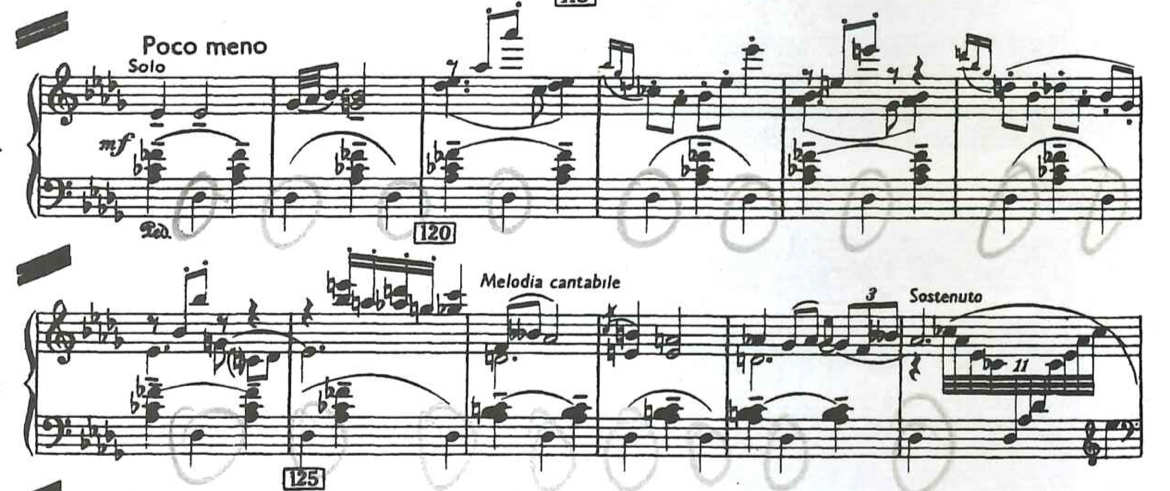
Score example 17, Piano Concerto, 2nd theme of the 1st. mov. bars 118-129
During the process of finding my way when playing this theme, I first started by moving towards the extremes of the use of rubato, at which point it sounded too free, just blurring the bar lines and shifting rapidly between the accelerando and taking too much time over and playing too freely the melodic lines. The musical expression was more towards the emotional, as well as lacking as much of a significant contrast of character in between the 1st theme and the 2nd more than I wished was the case. After some time, I came to the point at which I consdered that less is more, and I started to practice without rubato. In order to make sure that I had the core of the rhythmical structure of the whole 2nd theme in place, playing clearly and as rhythmically as composer has written, I created straight lines of phrases where they naturally flow and blend into the next phrase. After achieving a strong sense of the melodic lines, which sound more semplice, I started to explore the various dynamic shades, colours and a touch which could create this dreamy, transparent expression of the music in this section. I started to imagine in this part as it should be a huge contrast to the 1st theme, like a different world, and closer to the impressionistic music, such as in Debussy and Ravel, in terms of pianistic touch, colours, and atmosphere. I articulate the melody in a way that it is present, but the harmonies and the ornaments sound almost as if they are hanging in the air, in matte colours and varying between the pp and the mp. Only after achieving these dynamic shades would I add the rubato, which at this time was more sostenuto rubato. I must say that, after listening to my recordings of playing this theme in the way mentioned above, I found it sounds to be more improvisational, just by letting it speak for itselves, for indeed the composer had already written in a structure that is improvisational in itself.
The music here is very evocative, and it is possible to trace associations with folk instruments’ sounds and ways of playing in relation to some motifs, ornaments and passages. I use the left pedal (una corda), which helps me to find some soft colours for the specific harmonies that I wanted to underline in my playing. I use una corda in the parts where I imagine the imitation of the sound of qanon in the passages. Moreover, the use of the left pedal is combined with portamento, with a light touch at which point I imagine the imitation of plucking on the tar.
Khachaturian expressed his inspiration from folk musicians improvisational timing in many of his compositions: the piano concerto (cadenzas of the 1st and 3rd movements, the 2nd theme of 1st mov.), the poem for piano, in the middle section of the dance for violin and piano, in the Adagio from the Spartacus ballet, in the trio for clarinet, violin and piano, and in a number of other compositions. The significant element for me has been not only to find the freedom of the musical timing, but also to find a balance, where the search for freedom in musical timing and the improvisational expression of music is guided by a strong artistic sense and relevance, avoiding being on the brink of tasteless exaggeration.
The audio and video samples below are perhaps not as contrasting in approach as I had in the process of my search during the early stages of my preparations of this part. Even though they were made only two months apart, it is nevertheless possible to hear a transformation in approach in terms of timing where I have aimed to combine the improvisational expression of the flow, but at the same time ensure that it is balanced, organically connected, and without exaggerations.
Khachaturian, Piano concerto, 1st mov. 2nd theme, rec. in December 2017.
The same excerpt in live performance with KSO, rec. in February 2018.
In the development section, I think that the choice of how to use the pedal is a key for shifting the style of the part. I experimented with it, and came to the following conclusion: when I use it only on the downbeat and secco, no pedal on the 2nd and the 3rd beat, I come closer to the dry, well-articulated, sharp chord sonority, and I gain more clarity in the passages with non legato, motoric expression of articulation, which can sometimes seem reminiscent of the style/expression of some of Prokofiev’s piano works. When I have more pedal in the development sections (both on the chords and in passages), this causes the music to shift towards the more romantic side of it. I think that, by moving it towards this more romantic interpretation, it becomes more eclectic, as well as musically not speaking well with the whole structure of the concerto. It also makes it sound rather too heavy with the orchestra, wrapping in the pedal in clouds of overtones.
However, in the first passages of the development section, I tried to not only implement the well-articulated, dry clarity of the section, but also to create phrasing in such a way that it does not sound mechanical, like an exercise. Focusing more on dynamic changes, with contrasting crescendo - diminuendos, legato - non legato can help create in this part relief and flow, without losing the clarity in articulation.
The 2nd theme in recapitulation is presented with unusual sonority in the piano part: the cascades of folkish sonorities on the black keys, accompanied by sparkling notes of the left hand, sound very fresh, like a morning breeze with the lyrical folk-style melody played first on clarinet and then on flute in the orchestra, and then afterwards continuing with oboe, clarinet, and flute in a trio. It is interesting not only for its peculiar sonority in the piano part but also with some of the associations of an ensemble of the folk instrument’s imitation in the orchestra. During the performance, I played this part without accentuating the down beats of the bars, which many pianists normally do, in order to be sure of being in synchronisation with the orchestra. The whole section without pedal was too dry, so I experimented with the half pedal, some vibrating pedal, by keeping through several bars, which allowed me to gain this overtone’s “clouds”. I wanted my part to be like a shadow here - just a flowing sound cascade - as an atmosphere for the melody in the orchestra. It is possible to imagine these associations with folk sonorities in the orchestra: the clarinet-duduk, oboe-duduk, flute-blul, and the whole section of strings (violin, viola, violoncello, contrabass) supporting the melody with their sustained bass, as if playing the role of the dam. I took a slower tempo here to give more space to the clarinet, oboe and flute to play the melody with more freedom and flexibility, which also enabled me to use a little bit of rubato in my part.
With the phrase which connects the ending of this section to the orchestral transition to the cadenza, all of sudden the musical flow changes, unexpectedly shifting the style right from the bar line. Here, in the last phrase of this 2nd theme, I have no pedal and return to the dry, well-articulated sonority and sharp chords, making a turning point to a different direction, and allowing the cadenza’s musical expression to be so well perceived as an organic connection inside the structure of the whole movement.
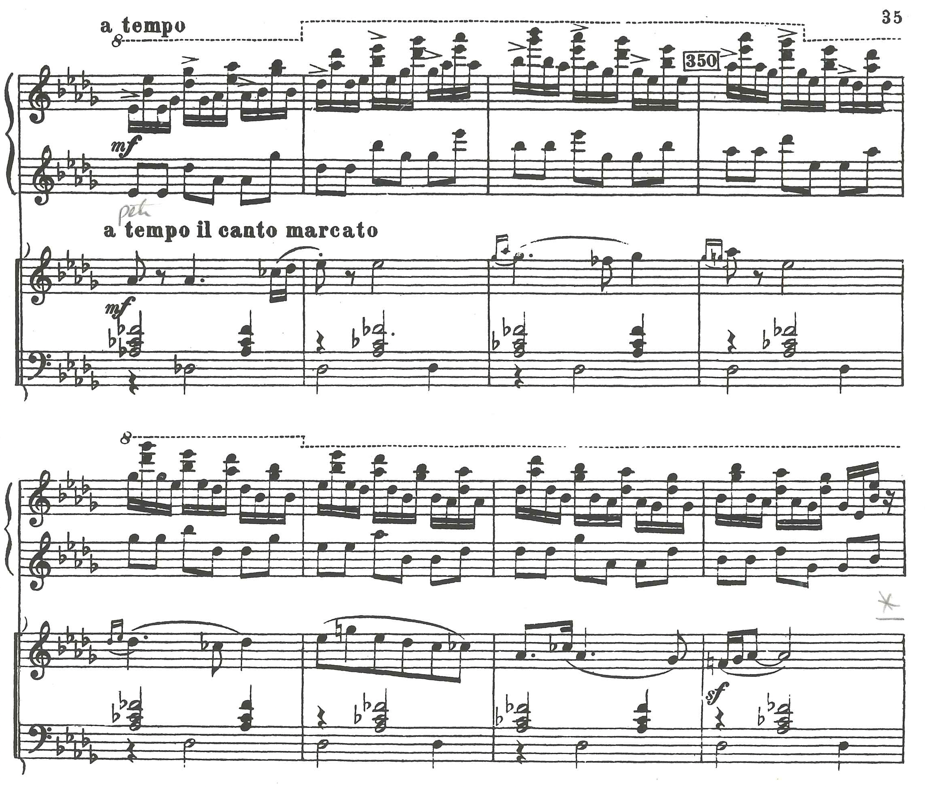
At the beginning of the Cadenza I start very dry, secco, well-articulated, with almost no pedal and the touch closer to being like an attack on keyboard. It was essential for me to achieve the flexibility and a perfect flow in the passages that I imagine to be an imitation of qanon. I use a very delicate touch but in a well-articulated manner, as every note sounds even and smooth in the passage as a one line. Similar passages remind me of Ravel’s Une Barque sur l’Ocean, where the composer used passages through the whole keyboard, with a similar technique in order to describe the ocean waves.

Score example 19, Piano Concerto, Cadenza, 1st mov. bars 443-444
In my opinion, the transition from the cadenza to the coda and the entrance of the orchestra is possible to interpret in two main ways by articulation and pedal:
1) Dry, no pedal, clarity on the right hand and “spooky” - a darker and well-articulated left hand.
2) More toward mild, melodic expression, which leads to more impressionistic sonority of the passage.
During performance, I believe that I had the combination of these two: I started more cloudy in terms of sound, using the left pedal and half right pedal, and a slower flow in the passage, then gradually, moving towards the crescendo, I had more and more dryness and clarity in my articulation.
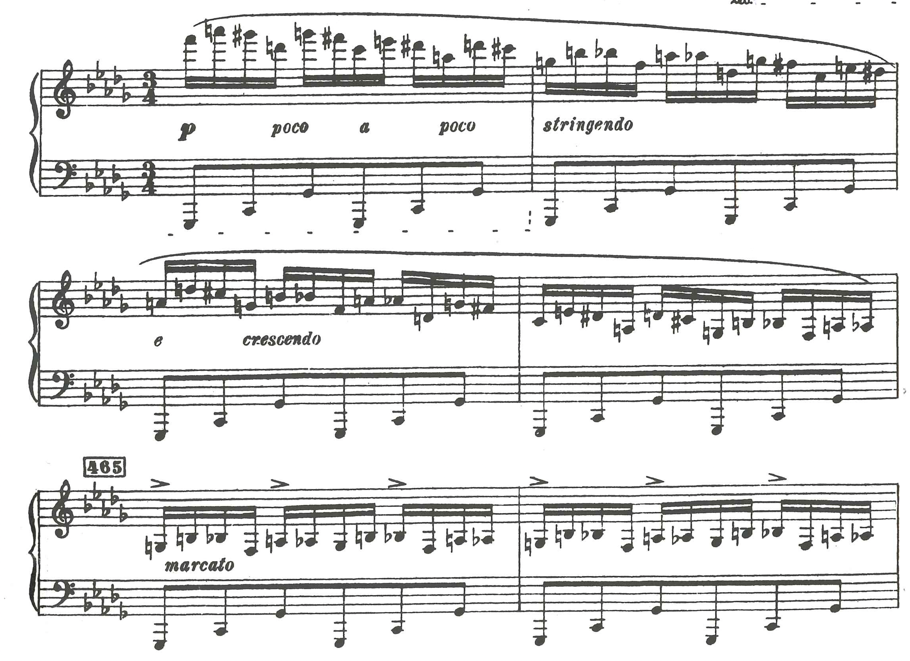
Score example 20, Piano Concerto, Cadenza, 1st mov. bars 461-466
The 2nd movement - Andante con anima evokes many feelings, memories and musical impressions from my childhood. The whole atmosphere of the main theme of this movement has a lyrical, meditative-sorrowful, philosophical character, evoking the feeling of a simple folk song that is sung quietly and alone. In this melody, I find the presence of the “Armenian soul”, which Khachaturian masterly brought from the simple folk melody to the classical forms of musical expression: the symphonic, lyrical-dramatic, and philosophical interpretation of it.
As Alina Pahlevanyan said to me during our conversation:[1]
Khachaturian was entirely absorbed by Armenian music, and it was already in the layers of his subconsciousness, as a fundament for his art. He (Khachaturian) personally said to me, “I am entirely absorbed by Armenian music, and I do not need citations from anywhere." However, he rarely used original melodies from folklore in his art, with a few exceptions, such as the folk song Vorskan Aghper, one of the folk songs that Khachaturian’s mother sang to him and later the composer used in his 2nd symphony and for the theme of piano concerto’s 2nd movement, which is an old folk song that he listened to during his childhood in Tbilisi, and in the solo sonata for viola, in the middle part we hear folk song Sari gyalin. So, we can count on our fingers how many original folk songs Khachaturian used in his art. It was extremely seldom (Pahlevanyan, personal communication, August 2017).

Score example 21, the original melody of the folk song that Khachaturian had as the basis for the theme in the 2nd mov. of the Piano Concerto (Khachaturian, 1972, p. 11).
Khachaturian himself recalled about this melody that he used in the piano concerto:
By taking this melody as the basis for the central theme of the Piano Concerto I obviously ran the risk of the critics tearing me to pieces when they learned the source of the music. But I departed so far from the original, changing its content and character so radically, that even Georgian and Armenian musicians could not detect its folk origin (Khachaturian, cited in Yuzefovich, 1985, p. 104).
As Gyodakyan says, “Khachaturian could recreate the spirit of lyrical folk melody with its restraint, pure and uplifting beauty” (Gyodakyan, 2006, p. 207, my translation from Russian).
To me the principle of the bold, creative approach to the folk melody is precious, when the composer, guided by his own ideas and artistic feeling, uses the folk melody only as a life-giving seed, as an initial intonational cell, which is possible to develop freely and boldly, to revise and to enrich (Khachaturian, cited in Gyodakyan, 2006, p. 207, my translation from Russian).
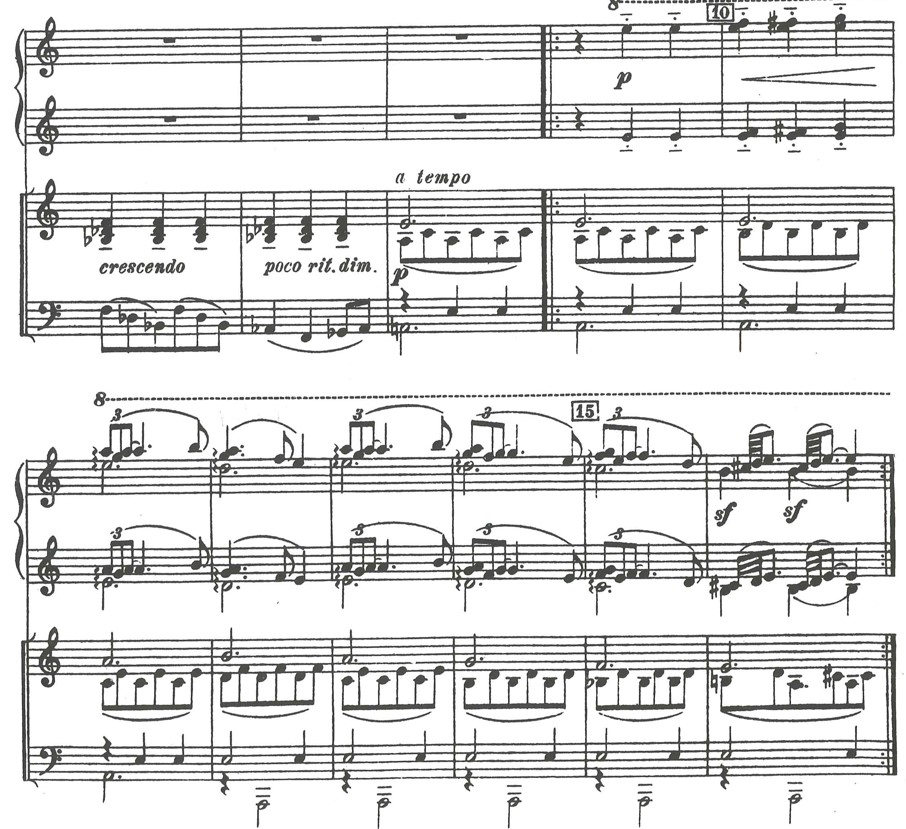
Score example 22, Piano Concerto, 2nd mov., bars 6-16
I imagine in the main melody in the piano part the sound of blul - transparent, sorrowful and hauntingly beautiful, supported by the basses on A, as a dam, played by the strings of orchestra (V-la, Cl., Cb.). The choice of tempo in this part was essential for me: I wanted a sharp, characteristic contrast between the lyrical 2nd movement and the volcanic, vigorous temperament, and brilliant, virtuosic style of the 1st and 3rd movements.
In this movement, the composer has flexatone in the partiture, when the main melody is exposed for the 2nd time in the orchestra. The term flexatone has a dual meaning; it is called the “instrument flexatone”, whilst on the other hand, the musical saw is also called the flexatone, since it has the capacity to flex the tone. Unfortunately, there is no information about what was in the mind of Khachaturian when he included the flexatone solo in the 2nd mov. of the piano concerto, and neither is there anywhere (at least to my knowledge) that mentions whether or not that he meant this part to be played on the musical saw. However, listening to the sound of the flexatone instrument, with its metallic, loud vibrations, I do in fact believe that sound of the musical saw is much more organic in terms of the context of the music, rather than the sound of the flexatone instrument, which disturbs the lyrical and gentle character of the folk-inspired melody. To achieve my imagined atmosphere and interpretation with the sound of the musical saw during the performance of the 2nd mov. we had Ben I. Nordby playing the musical saw (with amplified sound), placing him closer to the stage and to the piano, to gain more sound, more contact, and to underline his specific solo part to a greater extent during the performance.
Few composers of twentieth century music used a musical saw in their compositions; amongst those that did were Arthur Honegger (Antigone, 1924/1927), Dmitri Shostakovich (The Nose, 1929, Lady Mackbeth, 1934), and Khachaturian in the 1936, in 2nd movement of the piano concerto. The specific timbre of the musical saw adds an unusual sound and a feeling of thoughtful meditation, whilst also sounding, in my opinion, rather like human whistling.
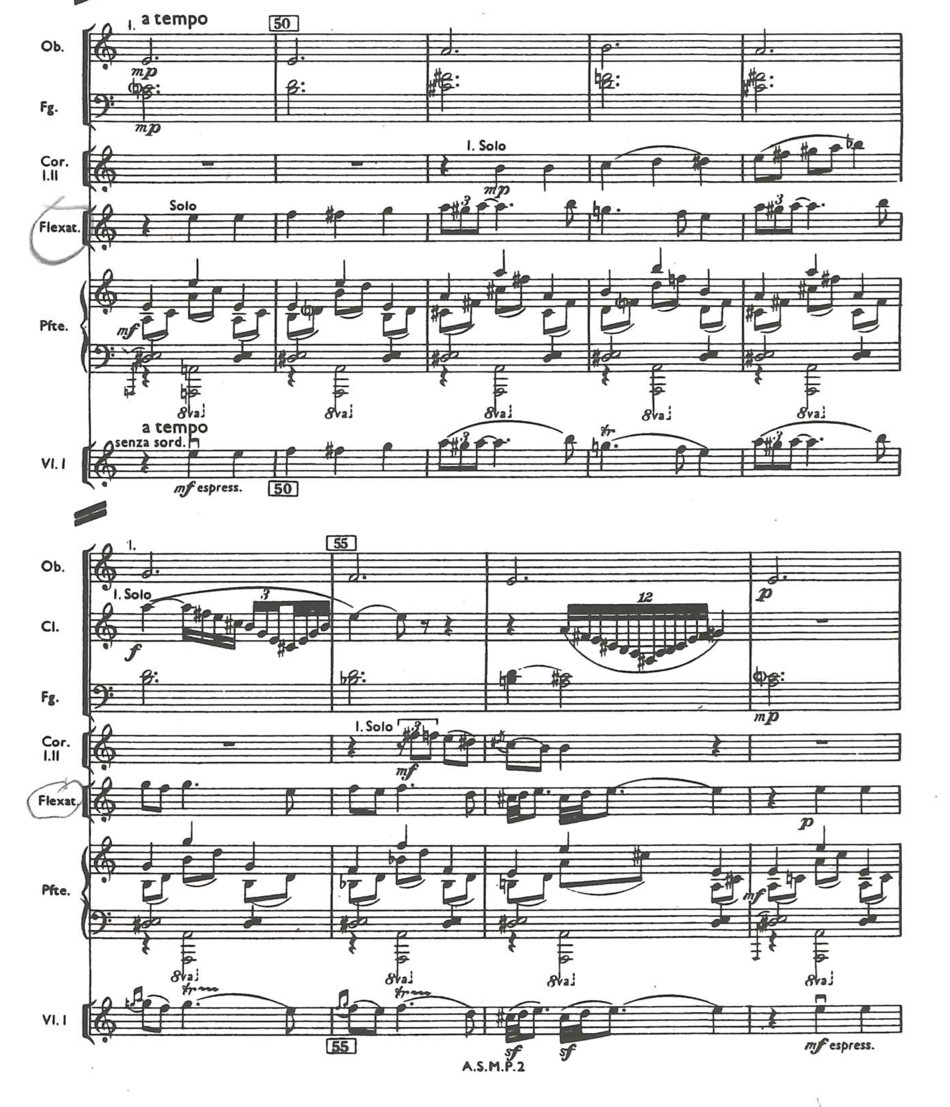
Score example 23, Piano Concerto, partiture, 2nd mov., bars 49-57
I consider the pianistic touch on keyboard to be a significant factor in creating an atmosphere in the lyrical parts of this movement. I have noticed on my recordings that, when I want to achieve some specific timbre in a particular passage (for example in bar 177), I keep my wrist slightly lower down from the keyboard, which cause me to feel the keys differently since I have better contact with my fingers on keyboard and a surfing-like movement, flexibility of the whole arm, relaxed but at the same time very precise in the fingertips which produces an even, round sound with a soft timbre and warm colours. It is important to listen to the downbeat tone all the way through until the first note of the passages and, in this way it does not sound abrupt but rather smooth, gently flowing and growing from the main note, creating melodic sound waves.
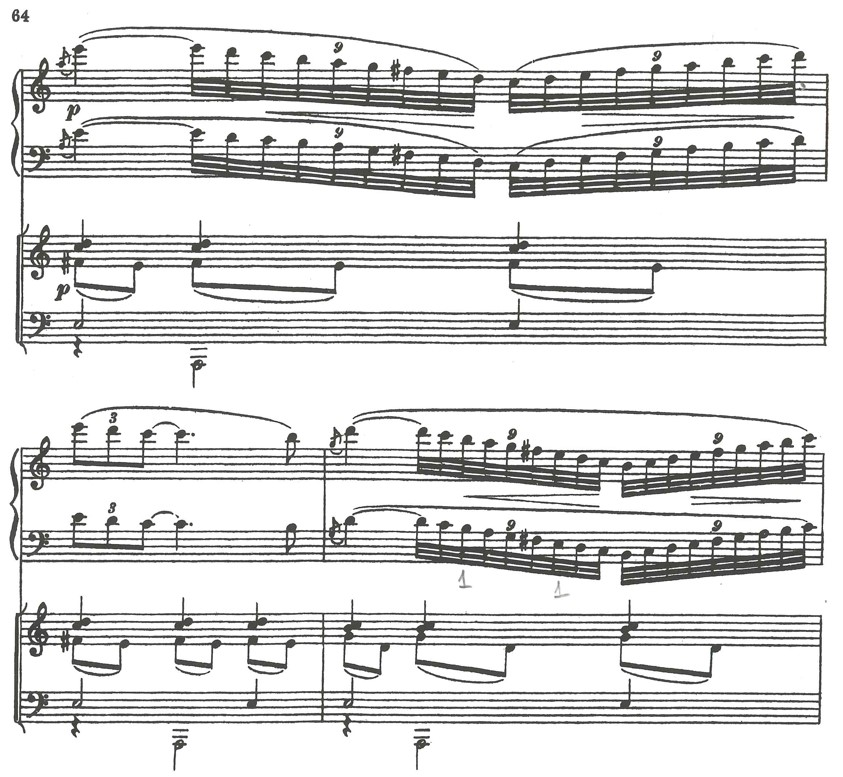
Score example 24, Piano Concerto, 2nd movement, bar 177-179
Khachaturian’s piano concerto, the theme in 2nd mov. played on the musical saw by Ben Nordby.
The 3rd movement presents a huge characteristic contrast to the 2nd movement. I consider the character of the main theme to be energetic and passionate, with elements of dancing rhythms and virtuosic brilliance in piano technique, and it requires precise articulation and clarity in the rhythmical patterns. Especially significant is the necessity to be very precise in articulation when the rhythm shifts from 2/4 to 3/8 and back to 2/4. I wanted to achieve this sense of the joyous, vigorous music without exaggerated pathos, being loud and heavy, and most importantly without extremely fast tempos. I played the main theme well-articulated, with the motoric, joyous movements of the passages, but at the same time, with the clarity and articulation, I aimed for a natural phrasing that would make it sound organic, light, and avoid it becoming an exercise with too motoric expression of the theme. As in other compositions of Khachaturian, in this movement too I perceive the piano to be a percussive instrument in some of the musical patterns which are dry and articulated, like a toccata, in character and temperament.
The second theme continues the energetic flow of the movement, and develops more dramatic, intense and darker musical colours, shifting the percussive and toccata style motion from the main theme towards romantic and emotional expression. I aimed to build my dynamics and pedalling on the second theme in a way that would make it sound more phrased, with build-ups and long lines. I have also had rubato in my timing, which makes it sound more expressive, together with the stable rhythmical patterns of the orchestra. With this theme it is easy to remain within the same dynamic level of sound, which will tire the listener with the overly dramatic and passionate chords of the whole 2nd theme, so for me it was important to consider how I would build the musical tension. I made sure that my 5th finger was articulated well and that it shaped the top voice clearly, whilst my thumb on the left-hand displays the chromatic lines of the accompaniment, helping to create the relief with the dynamics, crescendos, and diminuendos.
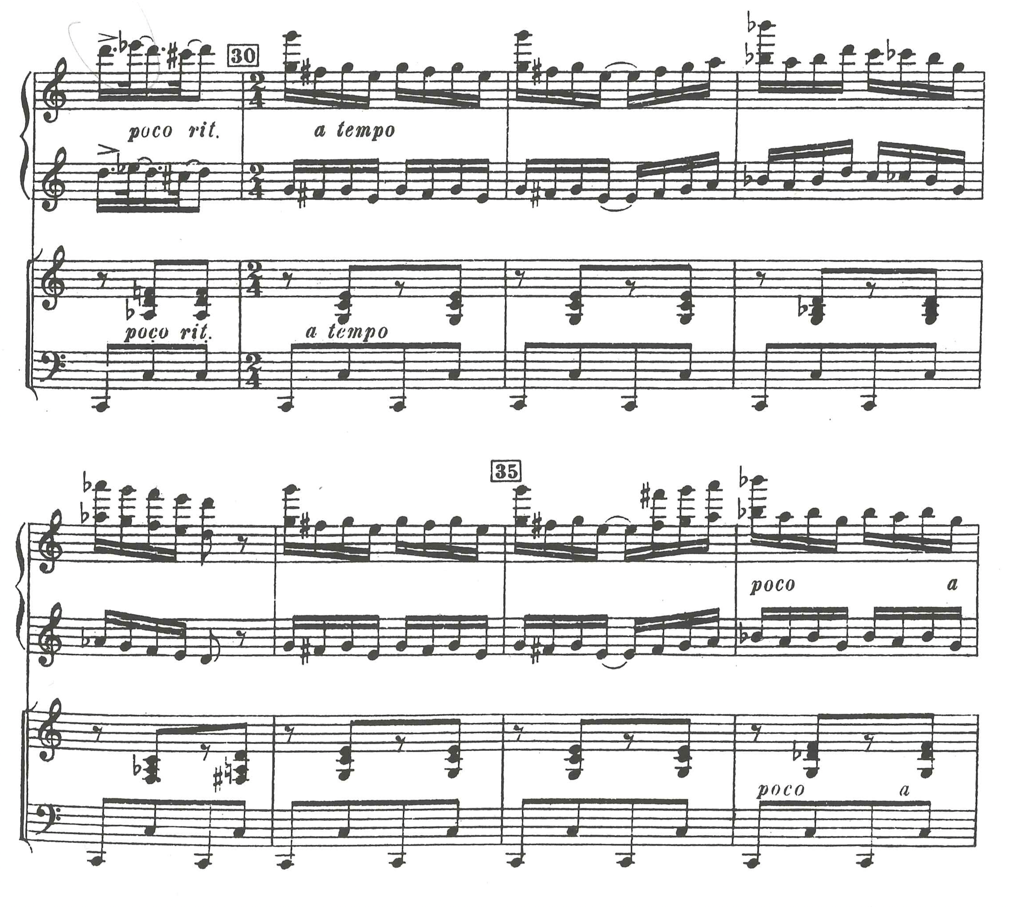
Score example 25, 3rd mov., main theme, bars 25-28
In the 3rd movement’s cadenza I aimed to achieve that the music sounded like folk-inspired improvisation and, in passages, motifs, rhythmical patterns imagined several folk instruments’ sounds such as: tar, qyamancha, dhol, and dap which made it interesting to explore and to find the pianistic touch, articulation, pedalling and other essential elements that would come closer to my imagined timbre of the folk instruments. It is not especially easy to evaluate to what degree I would be able to project to the audience my imagined evocations of sound; however, the attempt to come as close as possible to doing so has been my focus.
After the sf in bar 212, I imagine the tone C in the left hand’s accompaniment to the melodic motif of the right hand (enriched by the ornaments) as gentle beats on the dap.
I keep the half pedal in order to have all of the basses and overtones wrapped around the melodic motif of the right hand. I imagine the right hand’s ornaments and the melodic motif of this part (and similar parts in cadenza too) as an imitation of the gentle, plucking sound of the tar. I keep my wrist down, try to feel a perfect contact with the keys, and to produce a warm but articulated sound. The composer marks rubato at the point of the second occurence of this similar part. This is why I used little rubato the first time, in order to have space for even more freedom and flexibility in second time, also adding gradual accelerando in some parts.
The rhythmical patterns were, to me, clearly associated with the sound of dhol that I used to play with the pedal (some places indicated in the scores) at the beginning of the process when working on the piano concerto. As more time passed and I reflected more on the musical expression of that part, on the rhythmical structure (5/8) and the articulation, I chose to use less pedal, and just on the downbeat of the bar; I would play other beats of the bar in a well-articulated manner and dry (no pedal), which made it possible for me to achieve the precise rhythmical structure of the part which comes close to an imitation of dhol.

Score example 26, Cadenza, 3rd mov., bars 237-239
Instead of the right pedal indication of the score in bar 242, I use the middle pedal on the C, creating long sustained basses, as an effect of a dam, maintaining the bass with the middle pedal in bars 243-245 and building the melodic motifs and accompaniment on it, and when the tone disappears, I continue to build the overtones with right pedal. The whole cadenza, to me, is filled with free improvisational timing in every phrase and pattern, and the bar lines are out of context in this cadenza: I played it as if by ear, rather than like something learned.



Score example 27, Cadenza, 3rd mov. bars 240-246
In the Maestoso section, the composer returns to the main theme of the 1st movement, thus making a great arc within the whole compositional structure. It was important to have this arc in mind - the feeling of the wholeness of the classical compositional structure of the concerto, making the interpretation complete and organically connected, not only within the parts of each movement but also within all three movements in general.
The improvisational expression and timing of the music inspired by Armenian folk culture and the ashughs’ and gusans art, the use of rubato, choices of articulation, the pedalling, and the understanding and imagination of the sound of the folk instruments are essential not only for the cadenzas, but also for the whole piano concerto, which will have a significant impact on interpretation of it.
VIDEO OF THE LIVE PERFORMANCE OF KHACHATURIAN’S PIANO CONCERTO WITH KRISTIANSAND SYMPHONY ORCHESTRA (COMPLETE)
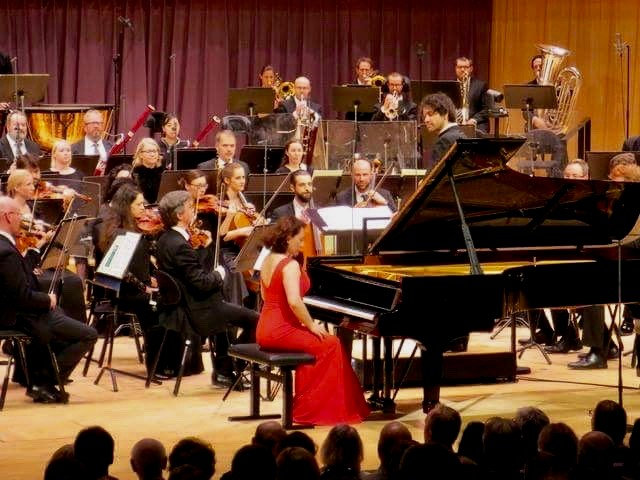
Photo from the performance of the Khachaturian’s Piano Concerto at Kilden Concert House, with Kristiansand Symphony Orchestra, 8 February 2018. Photo: Tone Lea
CHAMBER MUSIC
After working on Khachaturian’s Chamber compositions during the fellowship, in Autumn of 2018, I have made a recording of the Trio, the Sonata, the Song-Poem and Dance, as well as the three transcriptions from Ballets Spartacus and Gayaneh - Adagio, Sabre Dance and Lullaby, described further down on this page. To listen to the result, follow this link: Album with Khachaturian’s Music.
Trio for Clarinet, Violin and Piano
Khachaturian composed the trio for clarinet, violin and piano in 1932, when he was studying at the Moscow Conservatory in the class of N. Myaskovsky. This was the first instance of the trio genre in Armenian classical music. In this work, Khachaturian masterly managed to combine the free improvisational style, dance elements, and freely developed melodic lines inspired by Armenian folk music into the classical three-movement compositional form. Khachaturian’s trio received highly positive feedback from S. Prokofiev (1891-1953) when he visited the Moscow Conservatory and listened to the young composer’s works. Here are some reminiscences of Khachaturian:
It is hence not hard to imagine our excitement when one day (in 1933) Myaskovsky announced that Prokofiev was coming to the Conservatoire and that he wished to hear work of the students. Promptly at the appointed hour, the tall figure of Prokofiev appeared in the doorway of the director’s office. He came in talking animatedly to Myaskovsky and hardly noticing the looks of awe and curiosity with which we were regarding him. We were not a little nervous at the prospect of submitting our work to the judgment of this world-famous composer whose name was almost a legend to us (Khachaturian, cited in Shneerson 1959, p. 33).
The Trio was the first composition of Khachaturian performed abroad, outside the Soviet Union: “He liked my Trio and even asked me for the music to send to France. Needless to say, I was in the seventh heaven” (Khachaturian cited in Shneerson, 1959, p. 33). After this meeting, S. Prokofiev took the scores of the trio with him, and soon it was performed in Paris, at a concert of the Triton Chamber Music Society.
Prokofiev (…) was attracted by its independent tonal qualities, its rich melody and surprisingly relaxed manner of musical self-expression, and its sincere warmth. (…) The vivid emotional contrasts, the engaging boldness of the dance… an unexpected wave of sorrow… and again the even more reckless, unrestrained dance are striking, as is the composer’s skill, hidden under a cloak of improvisational exposition. The instrumentation of the Trio is original, the violin, clarinet and piano imitating the duduk, kemancha, and dool, folk instruments so dear to Khachaturyan’s heart (Yuzefovich, 1985, pp. 49-50).
In the process of shaping the interpretation of the trio, I introduced the composer’s inspiration from the folk instrument ensembles and the association of their sound with the violin’s and clarinet’s parts to Adam Grüchot and Stig Nordhagen, with whom I performed and recorded the trio and requested to search for possibilities of musical expression which would make the playing of the trio sound closer to the folk aesthetics in terms of timbre, articulation, the intonation of their instruments, and in their musical timing. As with the piano concerto, in the trio too the music and the piano part have an enormous palette of musical expression available, coupled with the space to explore the pianistic features in the context of composer’s folk inspiration. The choices of articulation and pedalling have been important to me, especially the parts where the piano plays the role of the percussive instrument in the ensemble, like the dhol, and also in order to gain the free musical flow filled with rubatos with the clarinet and violin, as well as finding an atmospheric and musical expression full of warm, colourful timbres in sound.
I wanted to emphasise the rhythmical motif in the piano introduction of the 1st movement, Andante con dolore, molto espressione, with its swaying movement, colourful and slightly sorrowful harmonies, and reflective manner, and arrive at a declamatory expression of it. This swaying, rhythmical motif reminds me of the Largo in the Msho Shoror of Komitas, which is similar in expression.
As I wrote earlier in the chapter about the piano concerto, Khachaturian rarely used original folk melodies as the sources of his themes, but still the intonations, modes and motifs in his compositions are firmly rooted in Armenian folk music.
Khubov, in his Monogram (Khubov, 1977, p. 66) of Khachaturian, raises an interesting example, comparing the opening theme of the trio with an Armenian folk song, Yes qez tesa[2] (I saw You), which was collected by Komitas. Below are score examples of the 1st movement’s main theme in the trio, and the folk song Yes qez tesa. The obvious similarities of the intervals, lyrical expressions and the spirit are simply undeniable.
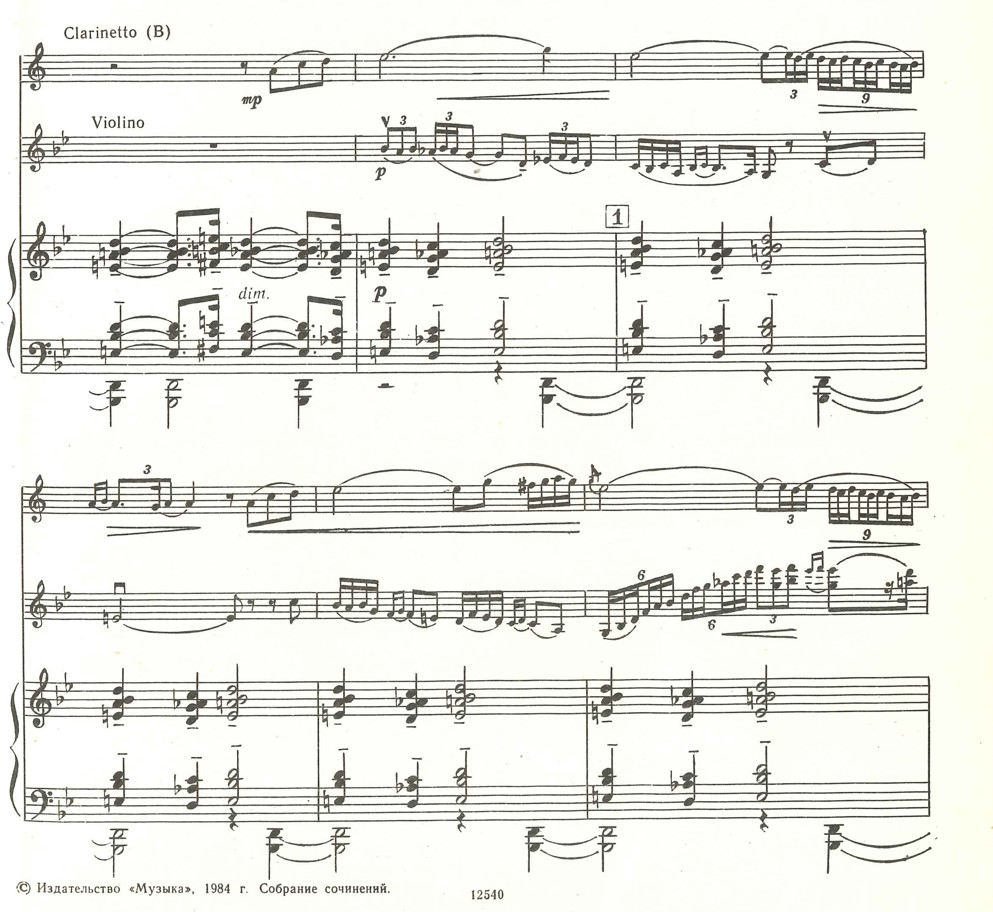
Score example 28, Trio,1st mov., bars 4-9

Score example 29, Komitas, Yes qez tesa (I saw You) Komitas, Complete works, vol. 11, RA NAS “Gitutyun” publishers, Yerevan, 2000 (arm). Retrieved from www.armenianmusic.am.
The choices of tempos and the relation of different parts’ tempos within the movement has also been essential for us. In the transitions from one tempo to another, we aimed for a natural, flowing musical expression that would seem improvisational and free.
An example of such transitions of tempo might be the 1st movement, poco piu mosso, where each instrument has melodic passages, enriched with ornaments. Regarding the musical flow, a feeling of completion is gained from the same pulse in the andante to poco piu mosso, and afterwards continuing on with the accelerando, which requires a perfect ensemble feeling from us, whilst at the same time bringing it into a state of organic wholeness, with free, flexible timing.

Score example 30, Trio, 1st mov., bars 13-16
Trio, 1st mov. recorded in 2016.
The same excerpt from the trio, recorded in 2018.
The 2nd movement - Allegro sounds like a folk-style scherzo, in which the spirit of the music is full of freshness and youth. In the Allegro, it was essential for us to choose a tempo that would transmit the light groove of the dancing rhythms and allow the pizzicatos of the violin part to sound, not getting lost or being rushed because of a too fast tempo. After the opening section of the Allegro, the Allegretto starts, and here the main theme of the 2nd movement sounds like a folk melody and reminds me of the flexible movements of a female dance. In the Allegretto section, it was important for me to phrase the piano part very smoothly, as it would have been written without bar lines, in a very calm manner which would allow the clarinet solo to sound like a simple folk style melody with a very supple motion. In the Allegretto, in violin part the choice of the articulation decides the character and atmosphere of the whole phrase. During the process, we came to the conclusion that the violin should not be too “present”, with too articulated sound, which would lead to it sounding like a march, but rather with a more “cloudy” sound – a more round and singing timbre, with longer articulated chords and more adjusted in accordance with the clarinet part which plays the main theme, thus achieving the flexibility and the supple rhythms of the Armenian dance elements, which do certainly exist in this movement.
In the Lento, during the short piano solo part I aimed for a more relaxed sound, which was free, mystical in a way, and atmospheric, before it continued with the violin’s almost improvisational melody, enriched by ornaments and full of rubato playing (as marked by composer) towards making a great contrast with the Allegro Agitato, a sudden interruption with the dancing and energetic rhythms of a youthful dance. In fact, this is the same theme as in the 2nd movement, except that it is transformed into a more energetic character and with a more active motion of musical texture and expression. In the piano part, I use almost no pedal, and my part’s expression has in mind the dhol’s sound: dry, articulated, and precise. In this part, it sounds as though more and more people are involved in the round dance circle, and this progresses to the climax in the Piu presto. The giant whirlwind of the dance approaches the reprise, the Maestoso pesante, where the main theme sounds there like a hymn - broader and with solemnity. The coda is the same introduction of the movement with its light and playful groove.
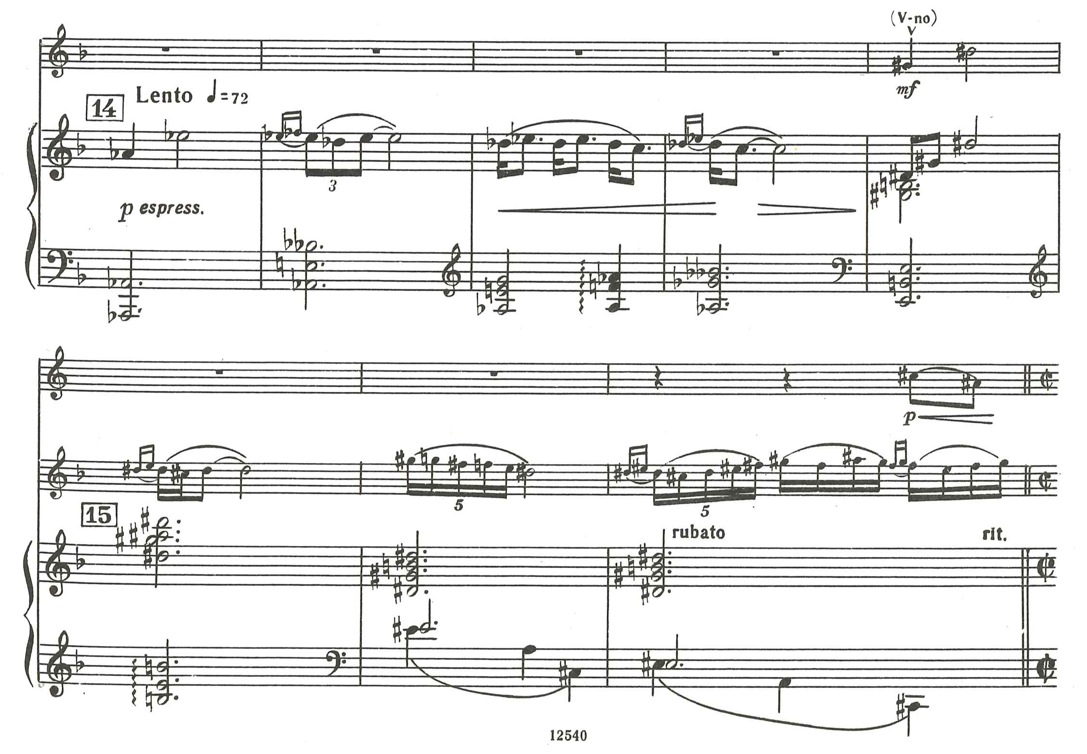
Score example 31, Trio, 2nd mov., bars 71-78
In the 3rd movement of trio, Moderato - Presto the folk-inspired dance rhythms are evident. The music is composed in the form of variations in which the folk-style melody is developed freely, each time with new timbres, colours and character. The piano in some sections of this movement is a percussive instrument, to me associated with the dhol in the sense of its energetic, rhythmical patterns of drumming. The natural flow becomes more and more active, as if involving all of the dancers, and soon reaches the musical climax in ff of bright harmonies in C, together with the clarinet and violin playing the melody in unison. It was essential for me, from bar 29, to have no pedal and to achieve a very light drumming effect for the violin and clarinet’s melodic parts.
Trio, 3rd mov., recorded in 2016.
The same excerpt from trio, recorded in 2018.
In the whole section of the Presto too, the piano plays the role of an exclusively percussive instrument, which I created the effect of drums with both pedalled voluminous rhythmical patterns, as well as those without pedal, dryer articulated patterns. This provided variety in the sound relief, and also added a vivid character, passion and temperament to the musical expression.

Score example 32, Trio, 3rd mov., bars 159-161
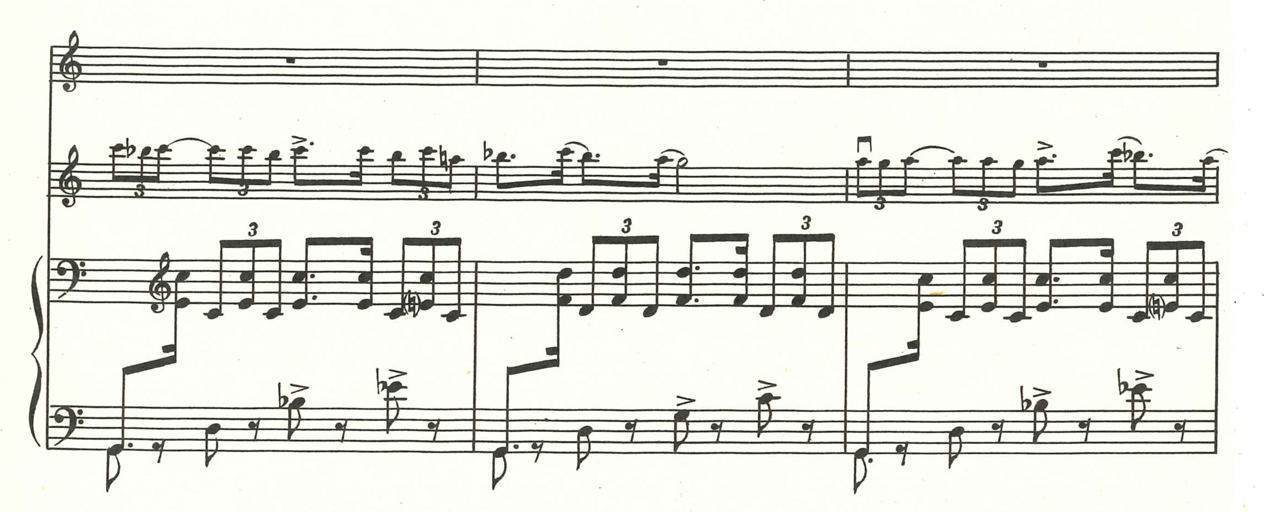
After the culmination, the Meno mosso concludes the 3rd movement with dark colours, but a warm E flat minor tonality. It provides a lyrical touch and a sorrowful character at the end of the trio. Gradually, the dancing rhythms sound more and further away - as if the main character of the story took another path and moved on to a place with own thoughts, listening to the group of folk dancers from a distance. We transmitted this effect with the help of the dynamics and timing, which gradually become softer and slower, finally disappearing in a mysterious ending.
Sonata for Violin and Piano
I wanted to interpret the vast variety of folk music, its sounds, rhythms, and images, in order to create something new. I probably would not have succeeded had I attempted to squeeze the characteristic sounds and rhythms of folk music into the Procrustean bed of European forms, for instance of the classical sonata form. With folk sources as a starting point, I sought to create my own form, something of a new alloy (Khachaturian, cited in Yuzefovich, 1985, p. 262).
The sonata for violin and piano is one of Khachaturian’s neglected and rarely performed compositions. I came across the scores of this composition accidentally, when I was buying several scores of Khachaturian from a private seller of books and scores during one of my visits to my homeland. I was astonished by the uniqueness of this composition which, to my ears, sounded like a revelation with its beautiful, lyrical melodies, vivid dance rhythms, its enormous energetic fusion of the virtuosic parts of violin and piano. Perhaps because of the critical approach to this composition by Khachaturian himself, who expressed about the sonata that it contained few nice themes, it was only published for the first time in 1984, and it remained unknown for many people. The reference I found so far to the piece was an editor’s note in the score of 1984 publication:
Sonata for violin and piano in two movements, written in 1932, has not been published, either in spite of containing “a few nice themes”-in the composer’s own words[3]. (…) Aram Khachaturyan, presumably, did not consider the sonata completed, which is suggested by the fragmentary character of its second movement and certain remarks on the title page hinting at his intention to have the second movement replace the first. The present publication is based on the manuscripts preserved at the Khachaturyan family archives; the violin part has been edited by Konstantin Fortunatov (Khachaturian, 1984, p. 9).
Naturally, I had a keen interest to research it and find my way of interpreting it together with Adam Grüchot, who profoundly shared my interest in this work, and was particularly keen on achieving the free, improvisational timing of music. To me exploring this Sonata was as a discovery of an unknown part of Khachaturian’s music.
The first movement of the sonata is in the style of free improvisation that is so characteristic of Khachaturian; it is full of warm, colourful timbres and contrasting harmonies. The second movement is more extensive and complex in the compositional structure, with a dramatic violin cadenza in the middle part, dazzling from the beginning with virtuosic and expressive parts of both instruments, presenting elements of various dances which I percieve as inspired from the intonation and rhythmical patterns of Armenian folk dances. To me, some of the parts in the sonata evoke associations with the impressionistic musical expressions, with their soft and atmospheric harmonies, and colourful timbres. Even though Khachaturian did not indicate in the scores, in some places of the piano part, I used the middle pedal to achieve my imagined sound and to hold the chords without blending them into the overtones of passages, thus creating separate sound layers of music.
In the first movement Khachaturian writes rubato as the tempo indication: Lento, rubato e espressivo, which makes me think that he considered that the whole movement should have the sense of free musical timing, enriched with rubatos, that would make it sound like quasi-improvisation.
The sonata has been neglected and is not popular among performers, which leaves great freedom for me to create my own interpretation of this large-scale composition, together with Adam Grüchot, having almost no references to recordings by other musicians or literary sources about it. The only recording of the sonata I found on Spotify was by Hidego Udagawa and Boris Berezovsky.
The music of the 1st movement is very lyrical and melodious, and is enriched by ornaments, both in the parts of the violin and piano. Particularly interesting are those ornaments with a chromatic upward motion in the basses of the piano part, and which create the impression of sliding from tone to tone - a glissando effect. In bar 63, from accelerando poco a poco, I use half pedal and vibrate it for three bars to achieve in that passage a blurred sound mass with blended overtones, and underline more the atmospheric aspect of the music rather than making it sound like a well-articulated, virtuosic passage.
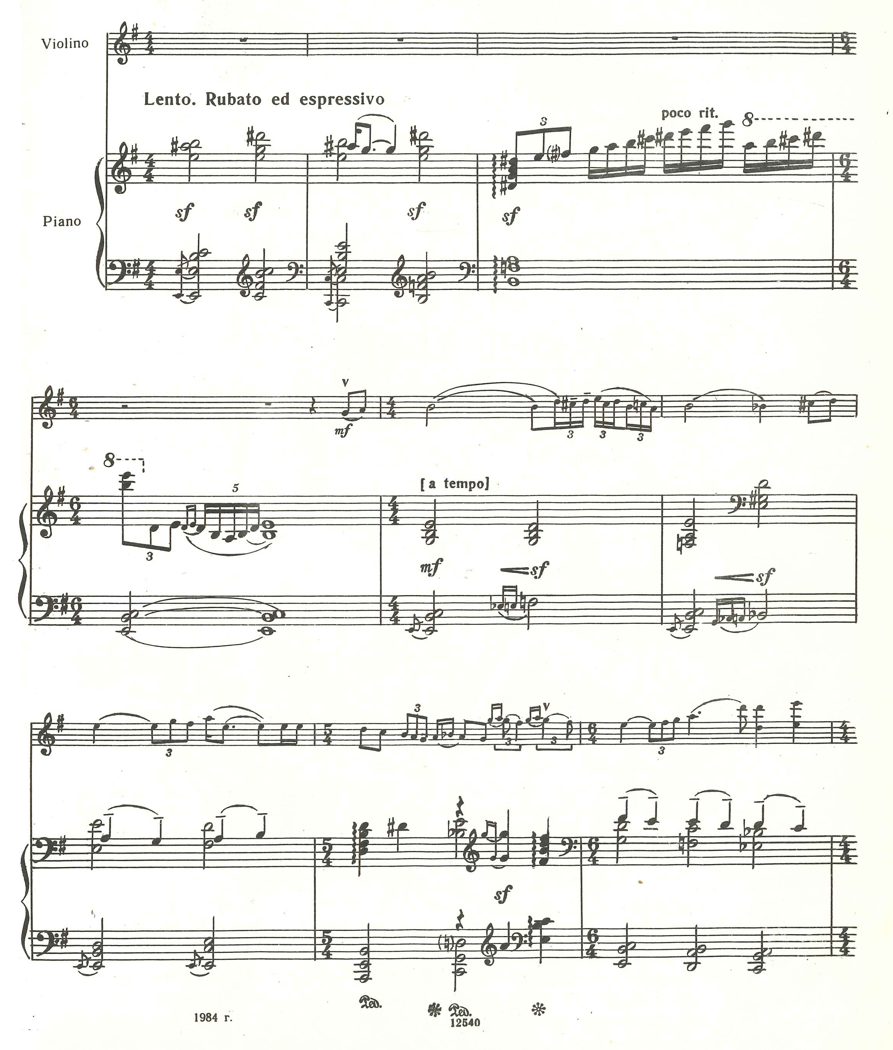
Score example 34, Sonata, 1st mov., bars 1-8
The 2nd movement is larger in form, and contains several parts of different folk-inspired melodic lyrical patterns and dance rhythms which contrast in expression, in rhythmical structure and in character. It was essential for us to create a meaningful and organic expression of the form, with temperament and vivid characters in all five parts within this 2nd movement: Allegro ma non troppo, Lento, Tempo I, Cadenza, Presto.
In the Allegro ma non troppo, Adam aimed for a light, lyrical, dancing groove for the first theme. In the piano part, I had in my mind the dhol’s sound and aimed to create a light, drumming effect with clear articulation and minimal pedalling on the passages in left hand from bar 23.
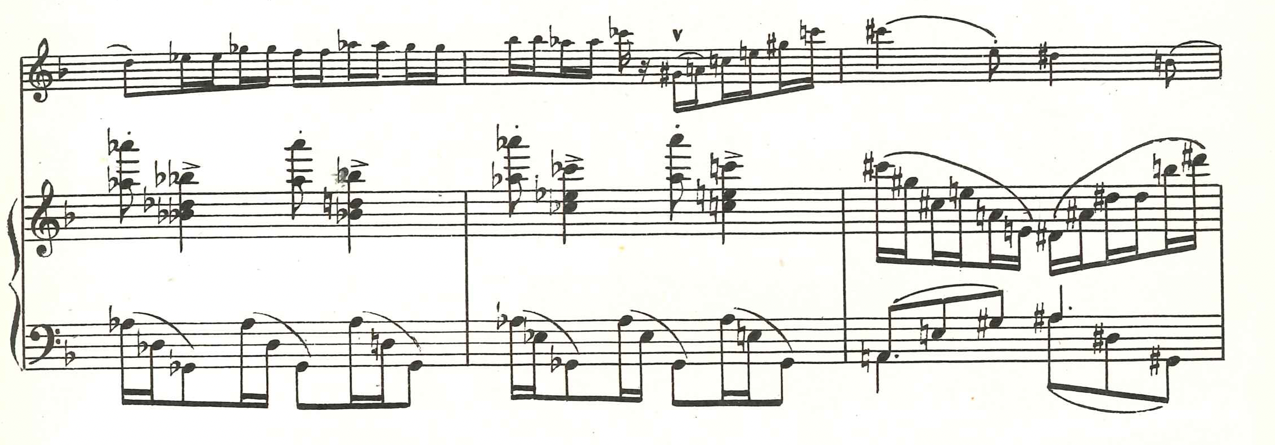
Score example 35, Sonata, 2nd mov., bars 28-30
In the Lento, bars 73-75, despite the fact that there are no pedal markings, I use the middle pedal to separating the two different layers: the chord textured melody in the upper register with fortissimo and the lines of melodic motifs, like an echo responding to the chords written in the lower register with non legato articulation and in sub. p. To me, such an example of music was rare for Khachaturian, because usually he utilised sustained or long notes/chords, which are characteristic for the basses in the lower registers of piano, which play the role of a dam, but not in the higher registers. In the project, using the middle pedal in all cases has been as a tool for me to create the effects of dam. However, even though this particular place is principally different from all of the previously mentioned music examples in reflections, here, in my opinion, the use of middle pedal and holding the chords so that they sound for as long as they are written, serves to achieve clarity in articulation and creating voluminous musical layers without mixing them under one right pedal.
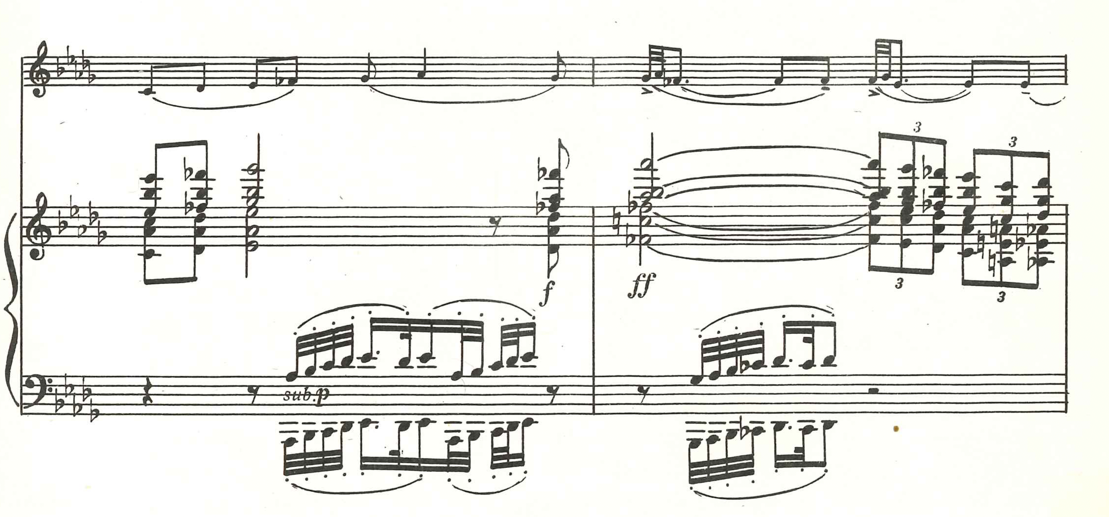
Score example 36, Sonata, 2nd mov., bars 74-75
In my opinion, the piano plays entirely the role of a percussive instrument such as dhol in the Presto. It contains contrasts in expression from soft, light drumming effects to more sub. sf - sudden attacks on keyboard, and to creating polyrhythmic layers with the violin part. In the presto there are only two places of pedal marking: the first is specifically noted by Khachaturian - “use the pedal” – without it being marked as to where to take it off, whilst the second is the right pedal over the last four bars of the movement. I use the right pedal (half pedal) over eight-nine bars to create a blurred, drumming effect, which sounds as if it were from a distance – unarticulated - mixing the overtones and then gradually shifting to a no pedal sound and a clearly articulated drumming effect.
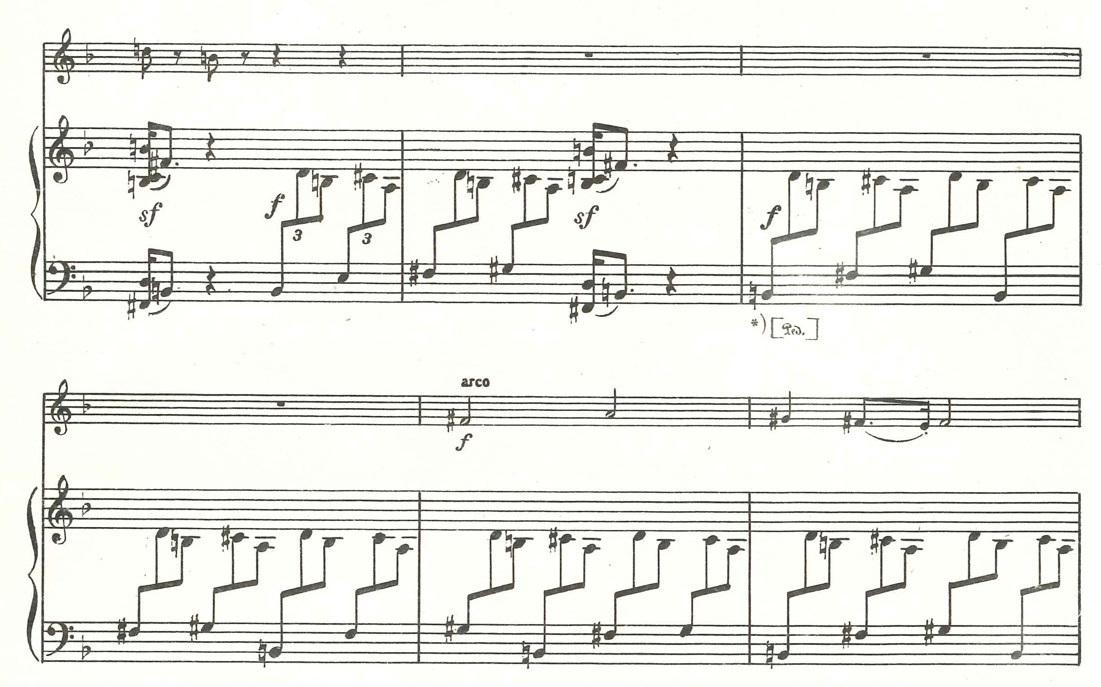
Song-Poem
Khachaturian wrote the Song-Poem in 1929 when he was studying in Moscow. He was inspired by a meeting with Shara Talyan and his ashugh ensemble in Armenia House and dedicated the piece in honour of ashughs.
The group sang rousing and lyrical sagas, as well as humorous and passionate Armenian love songs. The son of Jamani, a well-known Armenian ashugh, Shara Talyan had been taught to revere folk art since childhood. As a vocalist he enjoyed truly national popularity, both as an opera singer and a performer of Armenian songs (Yuzefovich, 1985, p. 37).
Khachaturian highly appreciated Talyan’s art and recalled,
I was closely acquainted with Shara Talyan; his wife, who sang and played the kemancha; and his brother, who played several instruments. My song-poem “In Honor of the Ashughs” was a gift as it were, to this talented group, whose performances I shall never forget (Khachaturian, cited in Yuzefovich, 1985, p. 37).
Indeed, the compositional form of a free fantasy is literally breathing with rubatos, colourful harmonies and sonorities which are far from the classical traditions of music at time the composition was written. Khubov even compares the Song-Poem main melody’s intonational and expressive characteristics with the Ashugh Jivani’s Dzakhord Orer, one of the most renowned Armenian ashugh songs (Khubov, 1977, pp. 58-59).
In writing Recitando con espressione as the first characteristic and tempo sign of the composition, the composer takes inspiration from the ashughs’ free improvisational musical timing - their passionate, expressive declamations, apparent from the very first bars. Both the piano and violin parts evoke associations with folk instrument sound and timbres: in passages, in dissonant chords and intervals, flageolets, ornaments, rhythmical patterns, and repetitions. These aspects have been essential for me and Adam when creating our interpretation of the piece.
The choices of tempos, both tempos of the separate sections as well as the organic connection of those between the different parts have been essential too.
We have aimed to create a meaningful musical expression for the listener, as the music comes forth more like an improvisation, as without bar lines, with the freedom and improvisational sense of the performance which would give the impression of as performers playing by ear, rather than by learning.
The metronome marking at the beginning of the piece (and in the sections that follow as well) do not make any sense regarding the timing of the whole piece in my opinion, and they do not contribute to a meaningful interpretation of the composition. In the Song-Poem continuously following the flow of the music - the natural phrasing of it, emphasising the harmonies and the dissonant chords, the long fermatas, and using rubato as a tool to achieving freedom and gaining a sense of the improvisational timing has been key for us in terms of finding a folk - inspired interpretation. During the process and on our way to achieving an ultimately free, improvisational timing, before we let the freedom in timing come to fruition for both of us during our performances, we limited ourselves to a rhythmically strict analysis of our parts, and ensured that the playing of our individual parts worked - vertically - exactly together, without any compromise of the score text, as composer wrote.
Khachaturian himself was against the anarchic looseness of musical development and, certainly, the tasteless exaggerations of musical timing have been against our musical principles too. During the conversations with Shneerson, Khachaturian shared his reflections, which have been an important key for us in terms of balance when searching for freedom in musical timing.
My love of improvisation has its source in folk music. But this is an innate peculiarity of my individuality as a composer and should not be taken as a leaning towards as anarchic looseness of musical development. Improvisation is not blind wandering ‘without compass and rudder’ over the keyboard in search of ‘spicy’ sonorities. Improvisation is only good if you know exactly what you are after, what you want to find. It then acts as a spur on your imagination, as an impulse to creative thought, enabling you to build up a harmonious and balanced whole. Improvisation should go hand in hand with the sense of logic in the construction of form determined as it is by the ideological conception of the work, by its content (Khachaturian, cited in Shneerson, 1959, pp. 41-42).
Khachaturian’s ideas regarding the composition’s improvisational style can also be perfectly referred to the performance style too, in my opinion. To build up a harmonious and balanced whole, meanwhile aiming for an improvisational expression of the performance, but “with compass and rudder”, to gain the natural flow and organic shape of the musical form and achieve the feeling in us that makes our playing sound/feel almost as if we were playing our parts by ear, as an improvisation – this sense came only after several live performances over the space of almost four years. During the recording in 2018, we were so comfortable with the ensemble sense of each other that we were completely focused on creating timbres, the warm atmosphere and the tiny shades of colours, and no less important was the spontaneous musical timing, agogics, so important for the achievement of a truly improvisational sense of free musical timing created in the moment.
As mentioned earlier, Khachaturian was greatly inspired by folk instrument timbres in the Song-Poem, and to achieve this imitation of folk instrument sound: the qanon in the piano part, and the string instrument qyamancha’ in the violin part were particular aspects to explore. The imagination of those instruments’ ways of playing, the sense of them that we have in our imaginations, and the sounds and timbres have certainly transformed our playing. For example, the piano introduction where I have repetitions and dissonant seconds, like sliding from tone to tone, I imagine as the qanon’s gentle plucking of the strings. I do play the whole passage on one pedal as marked, but the repetitions I aim to sound as clear and precise as possible, whilst meanwhile they remain rhythmically very free, creating an atmosphere - in a way an impressionistic sound mass - for the entrance of the main melody on violin, on which Adam’s intonation is close to folk aesthetics, with declamatory expressiveness, with the effects of sliding from tone to tone, and with quasi glissando sometimes.
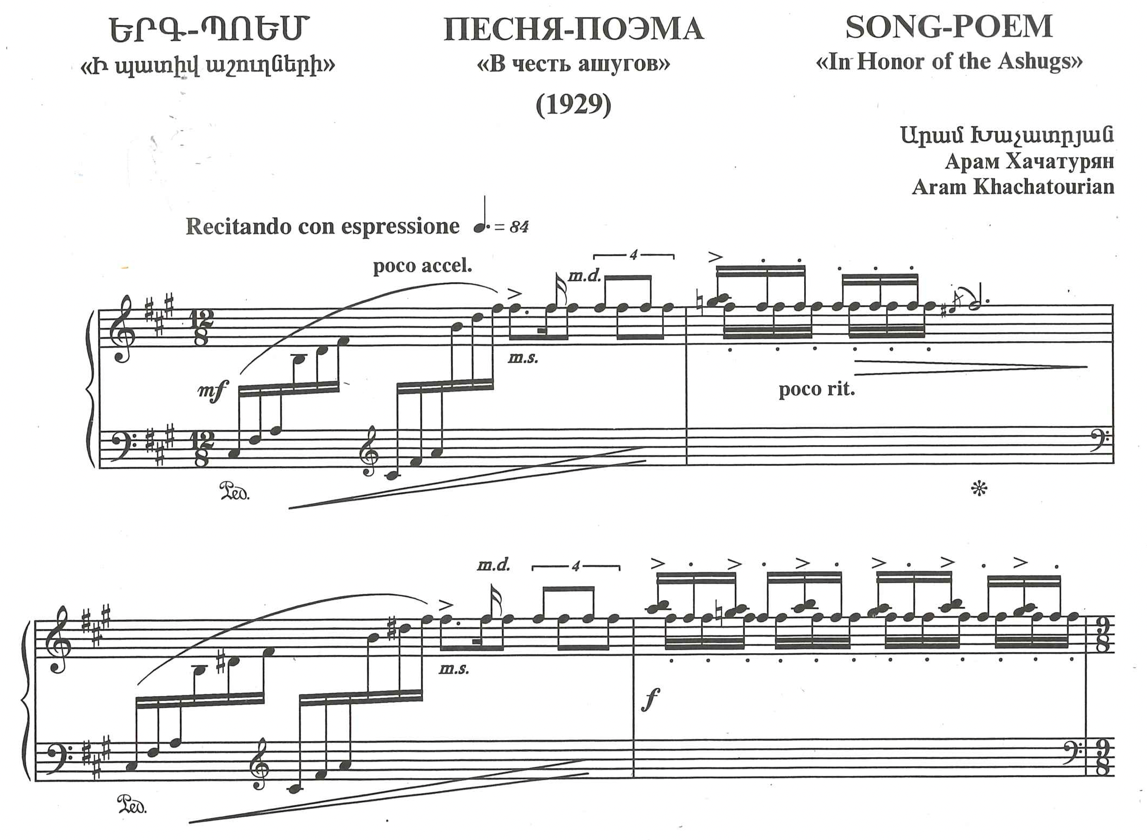
Score example 38, Song-Poem, bars 1-4
In the Poco meno mosso I wanted to keep the overtones of the passages with the pedal and build the phrases on it, using half pedal, sometimes just vibrating, in order to not lose the atmospheric “clouds” of overtones. However, at the same time, they were to be very transparent, with a lucid sonority. In the Meno mosso and a tempo rubato parts, the pedalling was important for me, with hanging overtones and a touch for the purposes of achieving a very warm timbre in sound: in my imagination a sense of a siesta, in which nature and all creatures are almost motionless under a hot summer sun in the mountains and fields.
In the Song-Poem, besides the strong impact of Armenian folk music, I think that the impressionistic sound aesthetics cross over from the composer’s folk inspirational sources to generate a unique sound that was very individual to Khachaturian. This was so important for me and for us together to explore and underline in our playing.
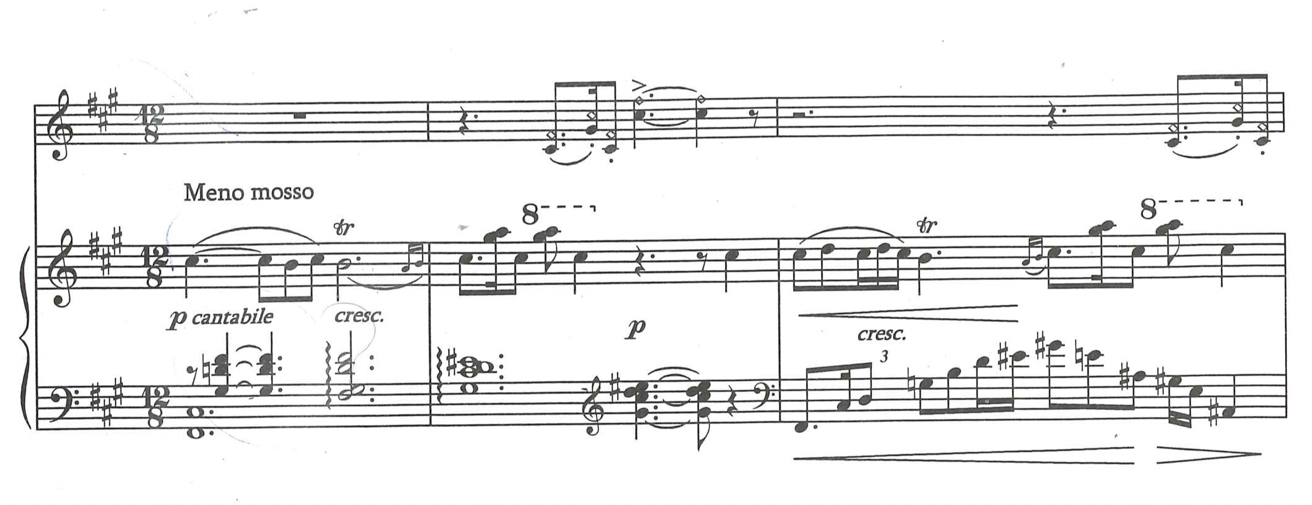
Score example 39, Song-Poem, bars 54-56
Dance
Komitas gave great humanitarian importance to the folk dance; Khachaturian followed him in this respect, implementing it in his music. Khachaturian was attracted by dance from youth. His first chamber piece was “Dance for violin and piano”, which was followed by a whole series of pieces of dance character. His first symphonic work was the five-part dance suite. (…) In Khachaturian’s numerous other works that are not directly associated with dance, we may often feel visible flexible movements of dance music with distinct specificity. Once again, we are convinced that the basis of the folk dance is specific to the nature of Khachaturian’s music (Khubov, 1977, pp. 76-77, my translation from Armenian).
In earlier chapters, I introduced the idea of two significant aspects that I strongly believe connect Komitas and Khachaturian: Armenian folk dance elements and the imitation of folk instruments’ sound/timbre in their compositions. For me one fascinating fact was that, while Komitas’ Seven Dances were composed in miniature compositional forms for solo piano, expressing musical simplicity and flexibility, as well as being charming in their own beauty of transparent, impressionistic-like colours, Khachaturian, went in his own direction, with more concert-style virtuosity even in compositions of a small form, anchored to these two fundamental traits from Komitas’ art: the imitation of the folk instruments sonority and the folk dance elements.
Khachaturian expressed his folk-inspired ideas of dance in various forms,
(…) starting from early pieces, where he learned to interpret the language of folk dance, melodies and rhythms and their specifics of national identity which express the feelings of the human soul, reflect on the whole pallet of feelings and senses, to the ballets, the music of which is a real dance symphony (Khubov, 1977, p. 77, my translation from Armenian).
This certainly refers to the monumental thinking of Khachaturian, who had no limitations in terms of choosing compositional form for the implementation of his ideas. Meanwhile, he was able express transparent, charming and delicate sonority even with the full orchestra, for example in the “Girls Dance with Tambourines”, full of the flexibility and charm of the girls’ choreographic movements. Here are some of Khachaturian’s compositions that are strongly inspired by folk dance elements: Dance for solo piano, dance for violin and piano, the clarinet trio’s 2nd and 3rd movements, numerous dance parts in the ballets Gayane and Spartacus, such as Sabre Dance, Ayshe’s Dance, the Maiden’s Dance, the Girls’ Dance with Tambourine, the Nymph’s Dance, Gayane’s Dance, Shalakho[4], the five-part Symphonic Dance Suite, and two Dances for Symphony Orchestra amongst other compositions.
Beside his numerous compositions with inspiration from Armenian Folk Dances, Khachaturian also introduces inspiration from other nationalities dances in his ballets Gayaneh and Spartacus: for example, the Georgian Lezginka, Uzbek March, Russian Dance, Qurdish Dance, etc. Indeed, it would be very interesting to delve deeper and to analyse all of the other dance examples in Khachaturian’s art, but this would make my project unnecessarily complex by posing new research questions and taking me far from its purpose.
Khachaturian wrote the Dance in 1926, while he was a student at Gnessin Music School, whilst studied in compositional classes for only a year, from 1925, with Mikhail Gnessin.
In the dance for violin and piano, our aim with Adam was to create a vivid, folk-inspired interpretation in which the lightness of the groove and the flexibility of the musical timing were of significant importance for us.
The dance starts with a short improvisational introduction, as a preparation before the dance.

Score example 40, Dance for violin and piano, bars 1-3
It was essential for us to keep the light flow of the rhythmical parts. I believe that, in Dance too, the piano plays the role of a folk percussive instrument such as the dhol or dap (tambourine), with its rhythmical patterns supporting the melodic lines of violin. The music, in some places, is reminiscent of the sonority of the folk string instrument qyamancha.
In the passages where composer’s mark is non legato, it was important for me to avoid using the pedal, even at the beginning of the passage, since I believe that overpedalling might ruin the impression of the light dance in similar passages on this piece and the whole would become more “cloudy” and heavy.
The section Quazzi pizzicato continues the dance groove, and ends with a beautiful climax of the main theme, which now sounds more “masculine” and grandioso. The Rubato section the commences with the piano solo, at which point I found, in the melodic line of the left hand, a sorrowful melody reminiscent, to my ear, of the sound of the duduk. I wanted a warm timbre to my sound at this point, playing molto legato, emphasising the melodic line of the left hand, playing freely and in a reflective manner. With the light Scherzando continuing the dance flow, but now sounding as if from a distance, it gradually moves toward the listener, as if involves all of the dancers together. The rhythm is faster, and the composer has changed the texture, where the passages end with upward motion, even though composer keeps the same rhythmical structure in the piano part. In the recapitulation, the dynamics are increased to forte and the tempo mark changes to Poco piu mosso. I wanted to make this gradual approach of the dancing people almost “visible” to the listener, using the crescendo from pp, mp, mf, f, and ff. This section of the Dance reminds me of Alborada del Gracioso, from Miroirs by Ravel where, in one of the sections, the composer creates an imitation with the help of dynamics as if a group of dancing people from the distance are approaching closer.
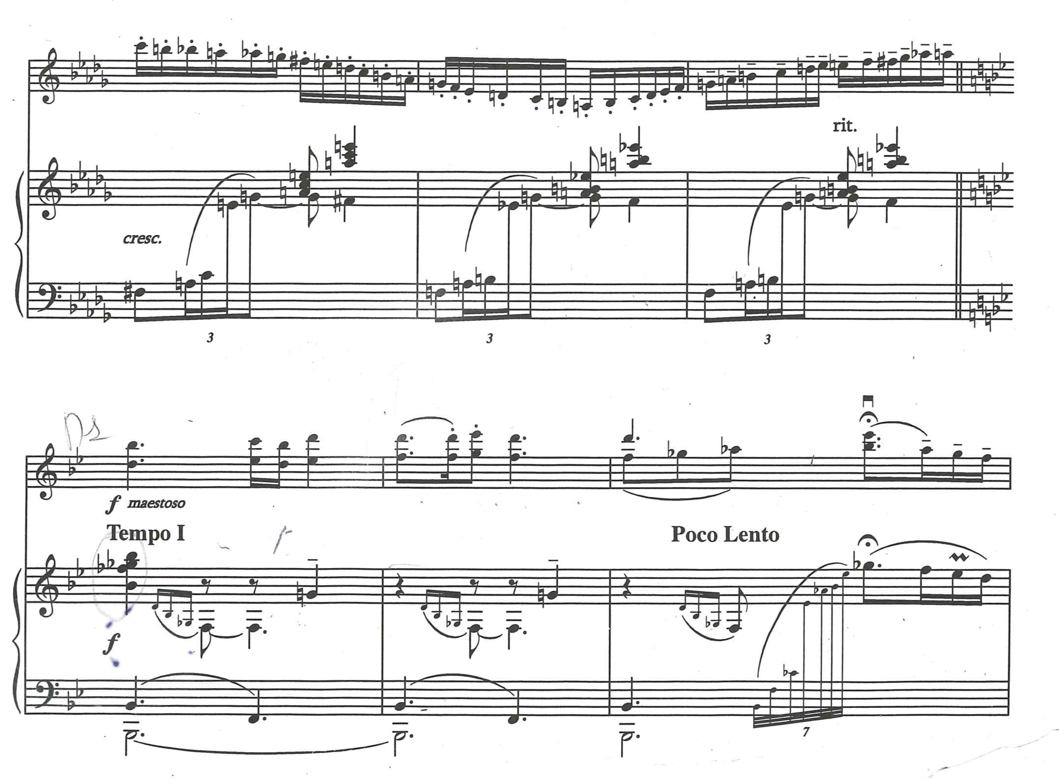
Score example 41, Dance for violin and piano, bars 88-90
The Arrangements from Ballets
Adagio from Spartacus
Playing Khachaturian’s Adagio from the Spartacus ballet in various concert arrangements has been especially warmly received in Norway, because many Norwegians themselves had fond memories from 1970s of the BBC production “Onedin Line”, which was shown in Norwegian Television, with spectacular scenes of fully rigged sailing ships accompanied by the music of Adagio.
Indeed, the music of the Adagio is very popular in many countries, and various transcriptions/arrangements from the ballet exist. I first performed the music from the Adagio in arrangement by Villy Sargsyan for solo piano, before playing it again in the version for classical trio. On the Khachaturian album, I present the recording of the Adagio played together with Leonardo Sesenna and Adam Grüchot in arrangement for violin, cello and piano by Avetik Pivazyan.
In 1948, Khachaturian, together with his outstanding colleagues Shostakovich, Prokofiev and Myaskovsky, was announced as a formalist in the Soviet Union. Their music was received with baseless criticism, which had a monumentally negative impact on their careers. Khachaturian spoke of these events as tragic days for him:
Those were tragic days for me. I gave eleven years of my life to the organization and leadership of the Composers Union. How we all waited for our Constituent Congress! And it was here and at this time that I was clouted on the head so unjustly. My repenting speech at the First Congress was insincere. I was crushed, destroyed. I seriously considered changing professions (Khachaturian, cited in Yuzefovich, 1985, p. 190).
It took long time for him to return to his enthusiastic mood and to create new compositions.
To gain his inner peace, he decided to go to Armenia: “I will fly to Armenia and travel around the villages and farms, keeping my ears and eyes open” (Khachaturian, cited in Yuzefovich, 1985, p. 192).
He travelled to the villages of Armenia, back to his roots, where so many associations from childhood were re-awakened within him. He wanted to listen to the peasants singing, to meet old and young, and to listen to ashughs and their improvisations:
I am moved to tears by the aroma of Armenian smoke hugging the roofs of the houses. It awakens in me some very distant associations so familiar since childhood, a night spent in a village, a sad song heard at a distance, as though from beyond the mountains. (…) I was overjoyed to learn that the song from the film Pepo is so popular. Some were even surprised to hear that the song had an author; they had considered it a folk song. What can be more gratifying to a composer than the realization that the people have made his song their very own! (Khachaturian, cited in Yuzefovich, 1985, p. 193).
Indeed, Khachaturian was loved in Armenia, and perhaps that love and reconnection with the motherland and people gave him an energy and inspiration to create new masterpieces. From 1950, he started to work on the Spartacus ballet, which he completed in 1954. He was inspired by the historical events that took place in the Roman Empire from 74-71 B.C, when about 120 000 slaves followed Spartacus, fighting for their freedom. The heroic theme, the struggle of Spartacus for freedom fascinated Khachaturian greatly: “the theme of an uprising against chains of slavery, a desire to bring freedom and independence to oppressed people” (Volkov, cited in Yusefovich,1985, p. 213).
From my point of view, looking back over the distance of so many interceding decades, this heroic theme could be viewed as his personal struggle against the Soviet System, the struggle of an artist who is forced to conform to the “frames” enforced upon him by that system.
The composer’s ability to transform his own struggle in his career in the late 1940s, was transferred from a personal perspective to broader context, and this was portrayed through the historical events of centuries back, giving an idea of Khachaturian’s monumental thinking. This was a significant aspect for us in creating a more “orchestral” and broad interpretation of the piece.
Our interpretation of the Adagio is perhaps the most romantic of all compositions presented on the Khachaturian album. The romantic farewell before the death of Phrygia and Spartacus, and the natural lyrical-romantic expression of the music with the classical instrumentation of this arrangement, inevitably create the romantically emotional, lyrical performance of the piece. With our choices of tempos and phrasing, the dynamics and colours, articulation, pedalling and intonation of the string instruments, we have aimed to express the broadness and emotional depth of the characters in Adagio.
Even though the context of the Spartacus ballet bore no connection to Armenian music, it is nonetheless possible to hear Khachaturian’s beloved various dam effects in music: the sustained basses, the pulsing basses, and entire phrases built on one harmonic bass note that are so characteristic of his unique art and deeply rooted in Armenian folk culture.
Sabre Dance from Gayaneh
Continuing the traditions of the Armenian folk dance represented in Komitas’ art, Khachaturian created his dance music according to his own expression, with concert style, virtuosity and orchestral mindset, mostly without referring to folk material sources.
With the Sabre Dance from the ballet Gayaneh, written in 1942, attributing a sword in the hands of dancers, I inevitably associate it with and make parallels to Zinapar from Msho Shoror: a male martial dance with roots as believed by Komitas to be from pagan times. Of course, the Sabre Dance has neither the inspiration from Msho Shoror’s Zinapar, nor musically any connection with it, but to me it is interesting to see the traits of the tradition from the folk martial male dance presented in the ballet of Khachaturian in his own, individual musical manner and musical expressiveness.
Sabre Dance too, like Adagio - perhaps even more than the Adagio - has numerous transcriptions and arrangements of the original score. It is considered to be Khachaturian’s most famous and recognised composition and, in composer’s own words, saying that he “would prefer other works of mine to be as popular as the Sabre Dance… (…) People remember the Sabre Dance when Khachaturian is mentioned. This is pleasing but also annoying” (Khachaturian, cited in Yuzefovich, 1985, p. 146).
I have performed the Sabre Dance with Adam Grüchot and Leonardo Sesenna in an arrangement for classical trio by Ruben Asatryan.
Often, the Sabre Dance is played extremely fast and the virtuosic aspect elevated, which, in my opinion does not accentuate the best qualities of the dance.
In the piano part, it was important for me to avoid pedalling almost at all during the entire piece, which underlined the articulation and the drumming effects of the piano.
In our interpretation, we have a tempo which gives us space to bring out the beauty of the middle section’s poly-rhythmical patterns, the warm timbres of the melody played on the cello, and the sharpness and clarity of each instrument’s articulation which I believe mirrors the composer’s ideas.
Lullaby from Gayaneh
The Lullaby from Gayaneh ballet has strong inspiration from Armenian folk music and sounds like a folk song, even though Khachaturian did not use any original folk melody here. The musical expression, the simplicity and the serenity of the melodic development appear to be full of folk spirit and atmosphere.
I performed the Lullaby in an arrangement for solo piano by Villy Sargsyan, and it became for me an initial seed from which point grew an exploration of the pianistic and interpretational possibilities of Khachaturian’s music within this project. I played the same arrangement on the piano with the folk instrument blul, played by Vigen Balasanyan.
These explorations in the Lullaby have been interesting points of departure for me when later, in 2018, we recorded the Lullaby in an arrangement by Avetik Pivazyan for classical trio together with Adam Grüchot and Leonardo Sesenna.
POEM AND TOCCATA
The Poem and the Toccata, written respectively in 1927 and 1932 for piano, are amongst the most famous piano pieces by Khachaturian. The Toccata in particular was often recognised immediately when I performed in different countries. In both pieces, I aimed for the improvisational, free timing inspired by folk music, as well as creating responses to my imagined folk instruments timbre.
The rhythmic, folk-dance-inspired elements of the Poem are clearly evident, and for the musical expression, it has been essential for me to imagine the sounds of the zurna and dhol that it evokes in me, especially in the opening section of the composition. In my opinion, this section has a distant connection to Komitas’ Msho Shoror in the aspect of musical expression with unrefined, raw sound that imitates the zurna and dhol.
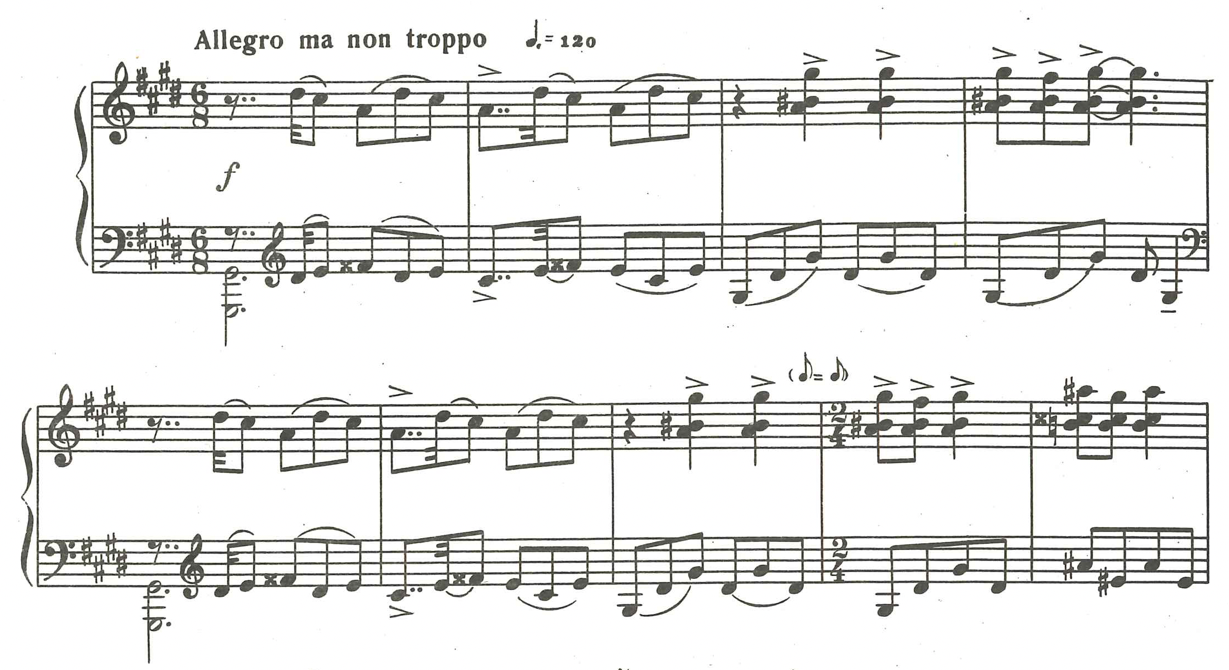
Score example 42, Poem, bars 1-9
Khachaturian, Poem, recorded in November 2017.
The Toccata starts with a powerful intro of motoric motion that sounds like an explosion, full of sharp harmonies and syncopation. The Andante espressivo - the middle part of the Toccata - comes as a big, characteristic contrast, with free musical flow after the motoric and rhythmical motion of the composition.
I can recognise the imitation of the dhol in the sections of repetitions and rhythmical patterns of the composition which were essential for me to articulate precisely, and to have conceptual choices with regard to pedalling that aimed to underline the percussive aspects of the piano. These repetitions in score example 44, surrounded with a sliding from upper to the lower tones, can be interpreted as an imitation of qanon too, since similar technique is characteristic of playing on the qanon. This gave me different opportunities in terms of searching for articulation, pedalling, touch and dynamics in this and similar sections of the Toccata.


Khachaturian, Toccata, recorded in November 2017.
-
See Meetings that Influenced Me. ↩︎
-
The web link to the performance of Sevada Hambardzumyan singing Komitas, Yes qez tesa. Retrieved from http://www.armenianmusic.am/en/audio/types=1&genres=19&sub_genres=38 ↩︎
-
Aram Khachaturyan: Episodes from Life and Work, from talks with musicologist Grigory Shneerson, Moscow, Soviet Composer, 1982, p. 71. ↩︎
-
Shalakho is a male folk dance, widely popular among Armenians. ↩︎